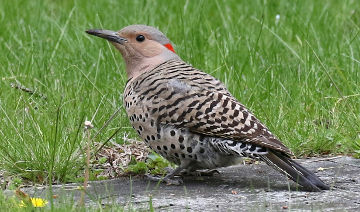Village News

PHOTO COURTESY OF GARRY KESSLER
A female flicker on the ground where it pecks and probes for ants.
April 24, 2020, Page A3
NATURE NOTES
By Annie Reid
Westborough Community Land Trust
Flicker: A woodpecker that pecks the ground
When you’re outside, do you sometimes hear a long, crazy laugh coming from nearby trees? Who makes that wild sound? Not a person, but probably our second-largest woodpecker, the blue-jay-sized northern flicker. It’s known for pecking the ground to eat ants and for the key ecological role it plays by excavating nest holes that are later used by other forest creatures.
You’re more likely to hear a northern flicker (Colaptes auratus) than to see one, especially now during the breeding season. Their laugh-like call is easy to notice because it’s unusually long, sometimes lasting 9-15 seconds. Along with drumming on wood (or sometimes metal), this call is part of a male or female flicker’s effort to attract a mate and defend a nesting territory. Like other woodpeckers, flickers go quiet once they’ve laid eggs. (Listen to flicker sounds at allaboutbirds.org/guide/Northern_Flicker/sounds).
You might spot a flicker on the ground, pecking and probing for ants, which make up about half its diet. It fishes ants out of their underground tunnels with a long, sticky tongue that ends in a barb. In doing so, the flicker can stick Its tongue out by 2 inches.
When the flicker flies off, you might see its white rump patch, which can help you identify it as a flicker. You might guess how the flicker got its name if you see one landing on a bare branch and glimpse a flicker of yellow from the underside of its wings or tail. Flashing their yellow is another part of what our flickers do in attracting mates and confronting rivals. Flickers in our area are known as yellow-shafted flickers. Flickers out west, in the Rocky Mountains and beyond, are red-shafted, flashing a salmon color underneath their wings and tail.
Up close, a flicker looks as if it’s wearing mis-matched prints, with stripes on its wings and back, and polka-dots and a black bib on its front. This patterning camouflages the flicker on tree trunks and on the ground. Both male and female have red on the nape of the neck.
How can you tell male from female? In yellow-shafted flickers, males have a black mustache stripe on the sides of the face, but females don’t. In red-shafted flickers, this mustache is red.
Flickers are widespread in North America. Some, at least, live year-round in our area. Others pass through in spring and fall, heading to or from Canada. Flickers have adapted well to life near people. Watch for them near woodland edges, bare ground, short grass, even in city parks.
How do flickers survive New England winters, when snow and frozen ground make ants hard to find? Fortunately, flickers do eat other food, such as beetles, larvae, and insects on bark. Especially in fall and winter, they also eat wild berries and seeds.
Now, in the nesting season, flicker pairs get busy making nest holes in dead trees. Look for their round, 3-inch entrance holes, big enough for a flicker or, unfortunately, sometimes for a European starling, which can’t dig its own hole but can evict a flicker. Flickers nest in open woods or swamps, including beaver swamps with dead trees.
Flickers lay about 6 eggs. Both male and female dig the nest hole, incubate the eggs, and tend the chicks. A small percentage of female flickers may take two mates and lay eggs in two nest holes.
Flickers tend to return each year to the same area where they’ve nested, but not necessarily to the same tree, so their old holes become available for many other animals and birds. If your property contains snags or dead trees that aren’t in danger of falling on buildings, driveways, or wires, consider letting the dead wood stand as a gift for flickers and other woodland creatures.